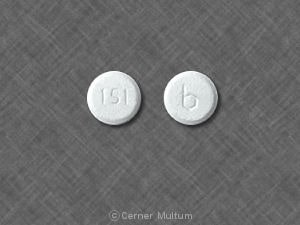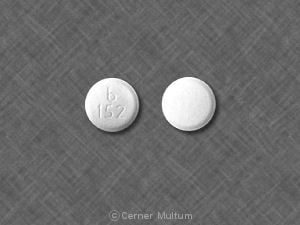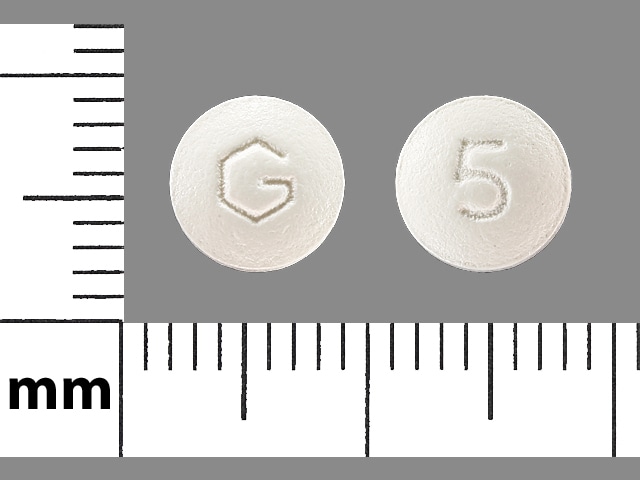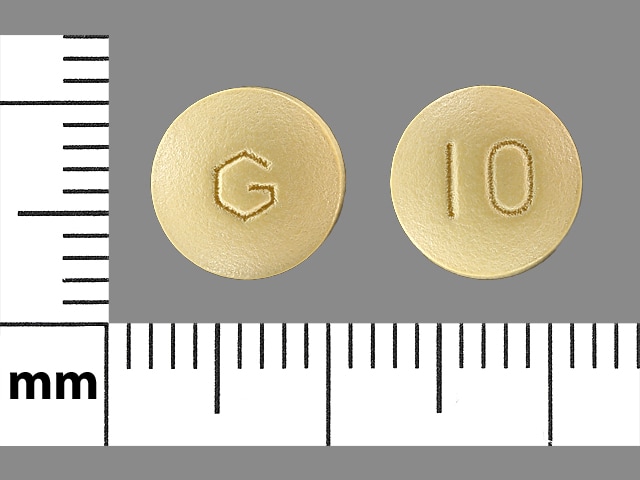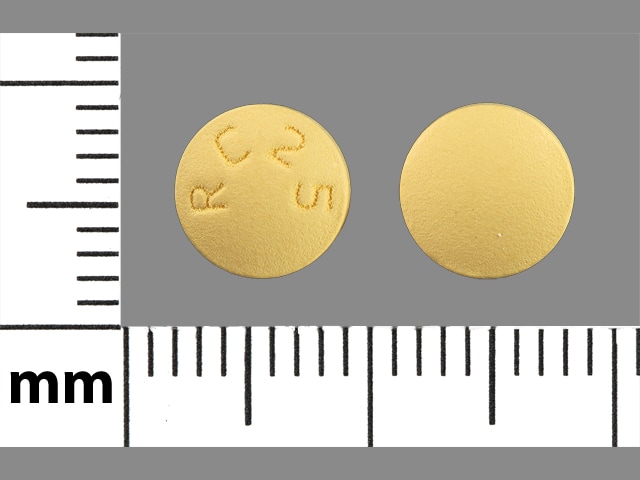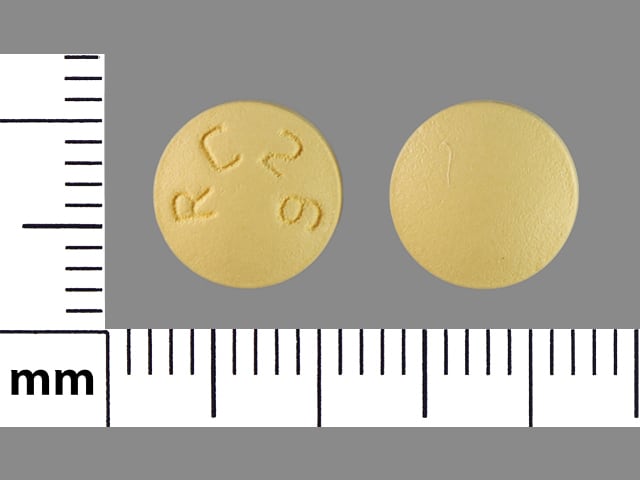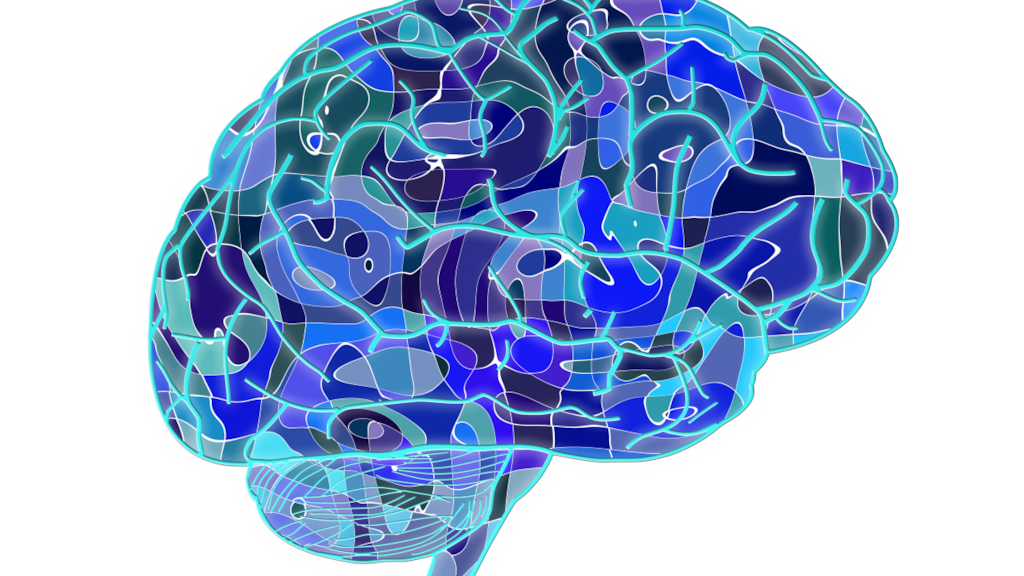Dosage Forms
Excipient information presented when available (limited, particularly for generics); consult specific product labeling.
Tablet, Oral, as hydrochloride:
Aricept: 5 mg, 10 mg, 23 mg
Generic: 5 mg, 10 mg, 23 mg
Tablet Disintegrating, Oral, as hydrochloride:
Generic: 5 mg, 10 mg
Pharmacology
Mechanism of Action
Alzheimer's disease is characterized by cholinergic deficiency in the cortex and basal forebrain, which contributes to cognitive deficits. Donepezil reversibly and noncompetitively inhibits centrally-active acetylcholinesterase, the enzyme responsible for hydrolysis of acetylcholine. This appears to result in increased concentrations of acetylcholine available for synaptic transmission in the central nervous system.
Pharmacokinetics/Pharmacodynamics
Absorption
Well absorbed
Distribution
Vdss: 12 to 16 L/kg
Metabolism
Extensive hepatic metabolism via CYP2D6 and 3A4 and glucuronidation to four major metabolites (two are active)
Excretion
Urine (57%; 17% as unchanged drug); feces (15%)
Time to Peak
Plasma: Tablet, 10 mg: 3 hours; Tablet, 23 mg: ~8 hours; Note: Peak plasma concentrations almost twofold higher for the 23 mg tablet compared to the 10 mg tablet
Half-Life Elimination
70 hours; time to steady-state: 15 days
Protein Binding
~96%, primarily to albumin (75%) and alpha1-acid glycoprotein (21%)
Use in Specific Populations
Special Populations: Hepatic Function Impairment
Clearance decreased 20% in patients with stable alcoholic cirrhosis.
Special Populations: Elderly
Clearance decreases with increasing age. When compared with patients 65 years of age, 90-year-old patients have a 17% decrease in clearance, while 40-year-old patients have a 33% increase in clearance; effect may not be clinically significant.
Special Populations Note
Body weight: For body weight from 50 to 110 kg, clearance increased from 7.77 to 14.04 L/hour, with a value of 10 L/hour for 70 kg individuals.
CYP2D6 genotype: When compared with CYP2D6 extensive metabolizers, poor metabolizers had a 31.5% slower clearance and ultra-rapid metabolizers had a 24% faster clearance.
Use: Labeled Indications
Alzheimer disease: Treatment of mild, moderate, or severe dementia of the Alzheimer type
Use: Off Label
Dementia associated with Parkinson diseasebyes
Data from a multinational, randomized, double-blind, placebo-controlled trial supports the use of donepezil in the treatment of dementia associated with Parkinson disease. Additional trials may be necessary to further define the role of donepezil in this condition Dubois 2012.
Based on the American Psychiatric Association (APA) guidelines for the treatment of Alzheimer Disease and Other Dementias, cholinesterase inhibitors may be given for patients with mild to moderate dementia associated with Parkinson disease. Only rivastigmine has been approved by the FDA for this indication, however, other cholinesterase inhibitors may be considered for use in the management of this condition.
Lewy body dementiabyes
Data from a randomized double-blind placebo-controlled study and an open-label extension study in Japanese patients supports the use of donepezil in the treatment of Lewy body dementia Mori 2012, Ikeda 2013. Additional trials may be necessary to further define the role of donepezil in this condition.
Based on the American Psychiatric Association (APA) guidelines for the treatment of Alzheimer Disease and Other Dementias, cholinesterase inhibitors may be considered for Lewy body dementia with dosing and titration similar to those for patients with Alzheimer disease.
Traumatic brain injurycyes
Data from a limited number of patients studied suggest that donepezil may be beneficial for cognitive impairment, short-term memory, and sustained attention associated with traumatic brain injury Kim 2009, Zhang 2004. Additional data may be necessary to further define the role of donepezil in this condition.
Based on the INCOG recommendations for management of cognition following traumatic brain injury, donepezil may be considered for deficits in memory in adults with traumatic brain injury in conjunction with use of objective and functional measures to assess the effects of the medication Velikonja [INCOG] 2014. Based on the Department of Veterans Affairs and the Department of Defense guidelines for the management of concussion-mild traumatic brain injury, donepezil is not suggested for the treatment of neurocognitive effects attributed to mild traumatic brain injury.
Vascular dementiacyes
Data from a meta-analysis suggest that donepezil may be beneficial for the treatment of cognitive symptoms of vascular dementia; however, clinical effects were modest Chen 2016.
Based on the
Contraindications
Hypersensitivity to donepezil, piperidine derivatives, or any component of the formulation
Documentation of allergenic cross-reactivity for drugs in this class is limited. However, because of similarities in chemical structure and/or pharmacologic actions, the possibility of cross-sensitivity cannot be ruled out with certainty.
Dosage and Administration
Dosing: Adult
Alzheimer disease: Oral:
Mild-to-moderate: Initial: 5 mg once daily; may increase to 10 mg once daily after 4 to 6 weeks; effective dosage range in clinical studies: 5 to 10 mg/day
Moderate-to-severe: Initial: 5 mg once daily; may increase to 10 mg once daily after 4 to 6 weeks; may increase further to 23 mg once daily after ≥3 months; effective dosage range in clinical studies: 10 to 23 mg/day
Dementia associated with Parkinson disease (off-label use): 5 mg once daily; may increase to 10 mg once daily after 4 to 6 weeks; may increase further to 23 mg once daily after the use of 10 mg once daily ≥3 months (APA [Rabins 2007]); Dubois 2012)
Lewy body dementia (off-label use): Initial: 2.5 mg once daily for 2 weeks, then increase to 5 mg once daily. After 4 weeks may further increase dose based on response and tolerability up to 10 mg once daily (Ikeda 2013; Mori 2012)
Traumatic brain injury (off-label use): Initial: 5 mg once daily for 2 to 3 weeks, then increase to 10 mg once daily (Kim 2009; Zhang 2004).
Vascular dementia (with comorbid Alzheimer disease) (off-label use): See Alzheimer disease dosing.
Dosing: Geriatric
Refer to adult dosing. Note: The Canadian labeling recommends a maximum dose of 5 mg once daily in elderly women (≥85 years of age) of low body weight.
Administration
Oral: Administer at bedtime without regard to food.
Aricept 23 mg tablet: Swallow whole with water; do NOT crush or chew due to an increased rate of absorption. The 23 mg strength is provided in a unique film-coated formulation different from the 5 mg or 10 mg tablet strengths, which results in an altered pharmacokinetic profile.
Aricept ODT: Allow tablet to dissolve completely on tongue and follow with water.
Storage
Store at 15°C to 30°C (59°F to 86°F).
Donepezil Images
Drug Interactions
Amifampridine: Acetylcholinesterase Inhibitors may enhance the therapeutic effect of Amifampridine. Amifampridine side effects may also be increased. Amifampridine may enhance the therapeutic effect of Acetylcholinesterase Inhibitors. Acetylcholinesterase inhibitor side effects may also be increased. Monitor therapy
Anticholinergic Agents: Acetylcholinesterase Inhibitors may diminish the therapeutic effect of Anticholinergic Agents. Anticholinergic Agents may diminish the therapeutic effect of Acetylcholinesterase Inhibitors. Monitor therapy
Antipsychotic Agents: Acetylcholinesterase Inhibitors (Central) may enhance the neurotoxic (central) effect of Antipsychotic Agents. Severe extrapyramidal symptoms have occurred in some patients. Monitor therapy
Benoxinate: Acetylcholinesterase Inhibitors may enhance the therapeutic effect of Benoxinate. Specifically, the effects of benoxinate may be prolonged. Monitor therapy
Beta-Blockers: Acetylcholinesterase Inhibitors may enhance the bradycardic effect of Beta-Blockers. Exceptions: Levobunolol; Metipranolol. Monitor therapy
Bradycardia-Causing Agents: May enhance the bradycardic effect of other Bradycardia-Causing Agents. Monitor therapy
Ceritinib: Bradycardia-Causing Agents may enhance the bradycardic effect of Ceritinib. Management: If this combination cannot be avoided, monitor patients for evidence of symptomatic bradycardia, and closely monitor blood pressure and heart rate during therapy. Exceptions are discussed in separate monographs. Consider therapy modification
Cholinergic Agonists: Acetylcholinesterase Inhibitors may enhance the adverse/toxic effect of Cholinergic Agonists. Monitor therapy
Corticosteroids (Systemic): May enhance the adverse/toxic effect of Acetylcholinesterase Inhibitors. Increased muscular weakness may occur. Monitor therapy
Dipyridamole: May diminish the therapeutic effect of Acetylcholinesterase Inhibitors. Monitor therapy
Fexinidazole [INT]: Bradycardia-Causing Agents may enhance the arrhythmogenic effect of Fexinidazole [INT]. Avoid combination
Haloperidol: QT-prolonging Agents (Indeterminate Risk - Caution) may enhance the QTc-prolonging effect of Haloperidol. Monitor therapy
Ivabradine: Bradycardia-Causing Agents may enhance the bradycardic effect of Ivabradine. Monitor therapy
Lacosamide: Bradycardia-Causing Agents may enhance the AV-blocking effect of Lacosamide. Monitor therapy
Midodrine: May enhance the bradycardic effect of Bradycardia-Causing Agents. Monitor therapy
Neuromuscular-Blocking Agents (Nondepolarizing): Acetylcholinesterase Inhibitors may diminish the neuromuscular-blocking effect of Neuromuscular-Blocking Agents (Nondepolarizing). Monitor therapy
QT-prolonging Agents (Highest Risk): QT-prolonging Agents (Indeterminate Risk - Caution) may enhance the QTc-prolonging effect of QT-prolonging Agents (Highest Risk). Management: Monitor for QTc interval prolongation and ventricular arrhythmias when these agents are combined. Patients with additional risk factors for QTc prolongation may be at even higher risk. Monitor therapy
Ruxolitinib: May enhance the bradycardic effect of Bradycardia-Causing Agents. Management: Ruxolitinib Canadian product labeling recommends avoiding use with bradycardia-causing agents to the extent possible. Monitor therapy
Siponimod: Bradycardia-Causing Agents may enhance the bradycardic effect of Siponimod. Management: Avoid coadministration of siponimod with drugs that may cause bradycardia. Consider therapy modification
Succinylcholine: Acetylcholinesterase Inhibitors may increase the serum concentration of Succinylcholine. Management: Consider alternatives to this combination due to a risk of prolonged neuromuscular blockade. Consider therapy modification
Terlipressin: May enhance the bradycardic effect of Bradycardia-Causing Agents. Monitor therapy
Tofacitinib: May enhance the bradycardic effect of Bradycardia-Causing Agents. Monitor therapy
Adverse Reactions
>10%:
Central nervous system: Insomnia (2% to 14%)
Gastrointestinal: Nausea (3% to 19%), diarrhea (5% to 15%)
Miscellaneous: Accidental injury (7% to 13%)
1% to 10%:
Cardiovascular: Hypertension (3%), chest pain (2%), syncope (2%)
Central nervous system: Headache (3% to 10%), pain (3% to 9%), dizziness (2% to 8%), fatigue (1% to 8%), abnormal dreams (3%), hallucination (3%), hostility (3%), nervousness (3%), depression (2% to 3%), confusion (2%), emotional lability (2%), personality disorder (2%), drowsiness (1% to 2%)
Dermatologic: Ecchymosis (4% to 5%), eczema (3%)
Endocrine & metabolic: Weight loss (3% to 5%), hyperlipidemia (2%)
Gastrointestinal: Vomiting (3% to 9%), anorexia (2% to 8%), gastroenteritis (≤1%)
Genitourinary: Urinary incontinence (1% to 3%), urinary frequency (2%)
Hematologic & oncologic: Bruise (2%), hemorrhage (2%)
Neuromuscular & skeletal: Muscle cramps (3% to 8%), back pain (3%), increased creatine phosphokinase in blood specimen (3%), arthritis (2%), asthenia (1% to 2%)
Miscellaneous: Fever (2%)
<1%, postmarketing, and/or case reports: Abdominal pain, aggressive behavior, agitation, cholecystitis, heart block, hemolytic anemia, hepatitis, hyponatremia, neuroleptic malignant syndrome, pancreatitis, peptic ulcer, prolonged QT interval on ECG, rhabdomyolysis, seizure, skin rash, torsades de pointes
Warnings/Precautions
Concerns related to adverse effects:
- Altered cardiac conduction: Donepezil may be associated with QT prolongation and torsades de pointes; use with caution in patients at risk of prolonged cardiac repolarization (Howes 2014). Cholinesterase inhibitors may have vagotonic effects which may cause bradycardia and/or heart block in patients with or without a history of cardiac disease; syncopal episodes have been associated with donepezil. Use with caution in patients with sick-sinus syndrome, bradycardia, or conduction abnormalities. Alzheimer treatment guidelines consider bradycardia to be a relative contraindication for use of centrally active cholinesterase inhibitors (APA [Rabins 2007]).
- Anorexia/weight loss: May cause anorexia and/or weight loss (dose-related).
- GI effects: May cause dose-related diarrhea, nausea, and/or vomiting; usually resolves in 1 to 3 weeks.
- Neuroleptic malignant syndrome: Rare cases of neuroleptic malignant syndrome (NMS) have been reported (Matsumoto 2004; Warwick 2008). Discontinuation of donepezil therapy may be necessary in patients presenting with symptoms of NMS (eg, hyperthermia, irregular pulse or blood pressure, cardiac arrhythmia, diaphoresis, muscle rigidity, mental status changes, elevated creatine phosphokinase [CPK], or unexplained high fever without additional symptoms).
- Rhabdomyolysis: Rare cases of rhabdomyolysis (including acute renal failure) have been reported after a few months of therapy (Sahin 2014) or in the days following therapy initiation and dose increase (Aricept Canadian product monograph 2014). Use with caution in patients with risk factors for rhabdomyolysis (eg, concomitant medications associated with rhabdomyolysis, history of muscular disorders, uncontrolled hypothyroidism, renal/hepatic impairment). Discontinuation of therapy may be necessary for marked elevation of CPK levels and/or symptoms (eg, muscle pain, tenderness or weakness, malaise, fever, dark urine) suggesting rhabdomyolysis.
Disease-related concerns:
- Peptic ulcer disease: Use with caution in patients at risk of ulcer disease (eg, previous history or NSAID use); cholinesterase inhibitors may increase gastric acid secretion. Monitor for symptoms of bleeding.
- Respiratory disease: Use with caution in patients with COPD and/or asthma.
- Seizure disorder: Use with caution in patients with a history of seizure disorder; cholinomimetics may potentially cause generalized seizures, although seizure activity may also result from Alzheimer disease.
- Urinary tract obstruction: Use with caution in patients with bladder outlet obstruction or prostatic hyperplasia; cholinomimetics may cause or worsen outflow obstructions, including possible exacerbation of BPH symptoms (APA [Rabins 2007]).
Special populations:
- Low-weight patients: Patients weighing <55 kg may experience more nausea, vomiting, and weight loss than patients ≥55 kg.
Concurrent drug therapy issues:
- Drug-drug interactions: Potentially significant interactions may exist, requiring dose or frequency adjustment, additional monitoring, and/or selection of alternative therapy. Consult drug interactions database for more detailed information.
Dosage form specific issues:
- Aspartame: Some products may contain aspartame, which is metabolized to phenylalanine and must be avoided (or used with caution) in patients with phenylketonuria.
Monitoring Parameters
Mental status, weight, symptoms of GI intolerance, symptoms of active or occult GI bleeding.
Pregnancy
Pregnancy Considerations
Adverse events have been observed in some animal reproduction studies.
Patient Education
What is this drug used for?
- It is used to treat dementia in people with Alzheimer's disease.
- It may be given to you for other reasons. Talk with the doctor.
Frequently reported side effects of this drug
- Diarrhea
- Nausea
- Vomiting
- Trouble sleeping
- Fatigue
- Loss of strength and energy
- Muscle cramps
- Lack of appetite
- Weight loss
- Headache
Other side effects of this drug: Talk with your doctor right away if you have any of these signs of:
- Severe dizziness
- Passing out
- Slow heartbeat
- Abnormal heartbeat
- Trouble urinating
- Seizures
- Heartburn
- Severe abdominal pain
- Vomiting blood
- Black, tarry, or bloody stools
- Trouble breathing
- Signs of a significant reaction like wheezing; chest tightness; fever; itching; bad cough; blue skin color; seizures; or swelling of face, lips, tongue, or throat.
Note: This is not a comprehensive list of all side effects. Talk to your doctor if you have questions.
Consumer Information Use and Disclaimer: This information should not be used to decide whether or not to take this medicine or any other medicine. Only the healthcare provider has the knowledge and training to decide which medicines are right for a specific patient. This information does not endorse any medicine as safe, effective, or approved for treating any patient or health condition. This is only a brief summary of general information about this medicine. It does NOT include all information about the possible uses, directions, warnings, precautions, interactions, adverse effects, or risks that may apply to this medicine. This information is not specific medical advice and does not replace information you receive from the healthcare provider. You must talk with the healthcare provider for complete information about the risks and benefits of using this medicine.
